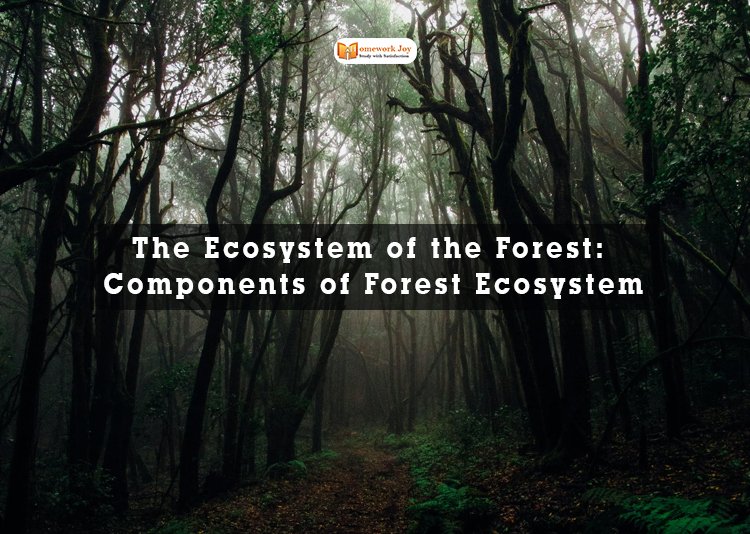The Ecosystem of the Forest is a scientific study of the associated patterns, flora and fauna, process, and Ecosystem in the forest. Forest management is also denoted as forestry and silviculture.
In the global system, the forest plays a vital role because forests produce approx, 28% of the Earth’s oxygen. Millions of people depend on forests because they provide a home for them. Also, many billions of people depend on forests in many other ways.
A global ecosystem is looking like an entire biosphere, according to ecologists. With the surrounding physical environment and living organisms interacting with each other, that Ecosystem refers to a functional unit of nature as the Ecosystem of the forest.
Certainly, the Ecosystem of the forest is a part of the Terrestrial Ecosystem. Alternatively, it has a large in size, small pond near a sea or a large forest.
The Ecosystem is divided into two broad categories that are aquatic Ecosystem and terrestrial Ecosystem. The aquatic system contains wetland, pond, river, and lake, although terrestrial systems involve forest, desert, and grassland.
The Ecosystem of the forest teaches us how living organisms can survive and live. Forest is also used for economic purposes like making wood products and for fuel.
The Ecosystem of The Forest
The Ecosystem of the forest is like a system or working unit that consists of all trees, plants, micro-organisms, insects, birds, animals, soil, and water.
The Ecosystem of the forest is very large and complex; therefore, it has a great species diversity. Moreover, compared to small ecosystems like grasslands and wetlands, it is more stable and resistant to detrimental changes.
The Ecosystem of the forest signifies the working unit of nature in biotic(living organism) and abiotic(non-living organism) components. Abiotic components refer to the substances like soil, air, and water, and Biotic components contain consumers, producers, and decomposers.
The Ecosystem’s numerous components are connected to each other like a food chain that depends on one another. In a food chain, basic requirements of life like air, energy, Carbon, nutrients, and water are essential to connect one thing to another.
Interaction of these components with each other in the Ecosystem and because of this interaction is self-sustainable formed.
Structural Features
There are two main structural features of the Ecosystem of the forest;
- Species: It signifies the identification or enumeration of the Ecosystem of the forest.
- Stratification: It helps every organism form a nutrition source to immerse a place in an ecosystem. Also, it mentions the vertical distribution of divergent species that inhabit different levels in the Ecosystem of the forest.
Every single organism has its own source of nutrition in the Ecosystem of the forest. Like in the Ecosystem of the forest, firstly come trees, then shrubs, then herbs, and the last is grass.
Components
There are three main components of the Ecosystem of the forest;
- Productivity: In productivity, plants play an essential role as a producer of the Ecosystem. Solar energy is most important to help plants play a vital role in productivity.
There are two types of Ecosystem in productivity;
- Primary productivity
- Secondary productivity
- Primary Productivity: During photosynthesis over a period of time, the biomass production per unit area or rate of captured solar energy by the plants signifies the primary productivity.
Primary productivity is divided into two categories;
- Gross Primary Productivity: Gross Primary Productivity in the Ecosystem of the forest is total biomass production or rate of captured solar energy by the plants. Although, in respiration, plants used a particular amount of Gross Primary Productivity.
- Net Primary Productivity: Consequently, the leftover biomass after consumption by producers or by plants. As a result, we can say that it is the available amount for the consumption of decomposers and herbivores.
- Secondary Productivity: By the consumers, the rate of involvement of food energy signifies secondary productivity.
- Decomposition: It is an oxygen-requiring process. In the process of decomposition, decomposers convert organic compounds into inorganic compounds like water, nutrients, and Carbon Dioxide.
Organic compounds have dead plants that are leaves, flowers, the dead remains of animals, and the bark of trees. Mineralization, Catabolism, fragmentation, leaching, and humification comes under the process of decomposition.
- Fragmentation: When detritivores disintegrate the detritus into tiny particles, it signifies
the process of fragmentation.
- Leaching: Inorganic nutrient water-soluble settle below into the soil and gravitate as unavailable salt this is the process of leaching.
- Catabolism: For making simple inorganic substances, fungal and bacterial enzymes decrease detritus; this shows the process of Catabolism.
- Humification: the collection of humus that goes through decomposition at a slow rate, thus leading to the process of humification.
- Mineralization: The release of inorganic nutrients and microbes degrade the humus in the process of mineralization.
During the decomposition of soil, the Humification and Mineralization process occurs.
- Energy Flow: Energy flows only in one direction at that time; plants detain solar energy then move the food to decompose. For food and energy relationships, organisms associate with different trophic levels connected to one another that form a food chain.
In every step of the energy pyramid, some energy is consistently lost as heat because the energy pyramid is always upright and flows from one trophic level to the next trophic level.
- Nutrient Cycling: Nutrient cycling is crucial because it signifies the storage and movement of nutrient elements through various components.
There are two different types of Nutrient Cycling:
- Gaseous Cycle reserve nitrogen and Carbon (i.e., hydrosphere and atmosphere)
- Sedimentary Cycle reserves phosphorus (i.e., Earth’s crust)
Major Forest Ecosystem
The three types of significant forest ecosystems are;
- The Tropical forest ecosystem
- The Temperate forest ecosystem
- The Boreal forest ecosystem
If you need any help regarding ecosystem of the forest essay writing then visit our website Homework Joy.
